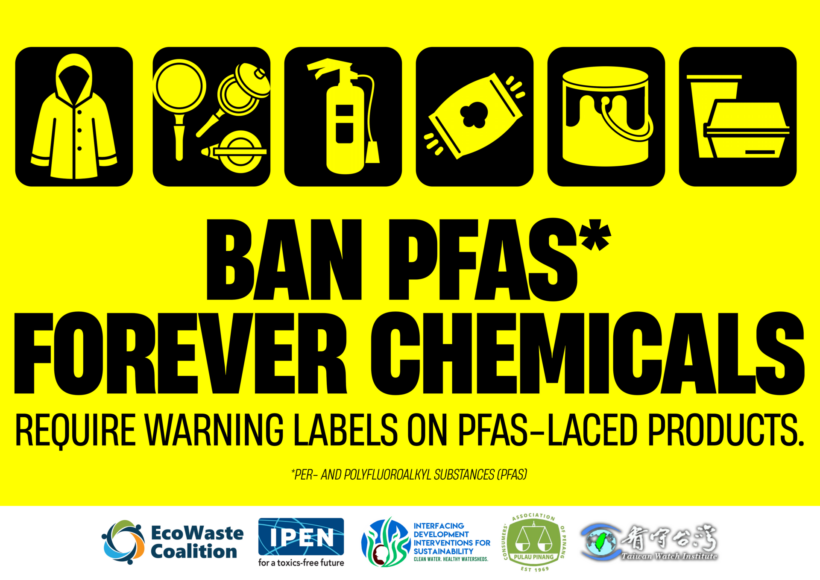25 March 2022, Quezon City. Alarmed by the unfolding global contamination crisis linked to the largely unregulated production and use of the so-called “forever chemicals,” the EcoWaste Coalition has appealed to the Environmental Management Bureau (EMB) to consider banning these extremely persistent substances.
Through a letter sent to the EMB, the toxics watchdog group proposed that poly-fluoroalkyl substances (PFAS), which have earned the nickname “forever chemicals” because they hardly degrade in the natural environment, should be banned as a class to halt the extensive PFAS pollution affecting the entire planet.
The group cited studies illustrating the alarming omnipresence of PFAS in the global environment, including the detection of PFAS 1) in rainwater in every corner of the earth at levels that “often greatly exceed” the safety limits, 2) in over 30,000 umbilical cord blood samples of newborn babies, and 3) in the blood of over 330 wildlife species, including endangered or threatened animals.
In the Philippines, the group noted a study by researchers at the University of the Philippines (UP) Institute of Biology that found elevated levels of PFAS in women with breast cancer in the Greater Manila Area.
Like in other low- and middle-income countries, PFAS are not regulated in the Philippines, the group said. While some of them may be listed in the Philippine Inventory of Chemical and Chemical Substances (PICCS), there is no specific regulation governing the thousands of PFAS chemicals that are used in a wide array of consumer, commercial and industrial products, the group pointed out.
The Organization for Economic Cooperation and Development (OECD) lists 4,730 substances in its PFAS global database. A recently submitted European Union restriction proposal, which provides for a broader definition of PFAS that will also cover substances, mixtures and articles, will, if adopted, restrict at least 10,000 PFAS compounds.
Currently, PFAS and its derivatives are not mentioned in the country’s “list of banned, restricted, severely restricted and regulated chemicals” as per the National Profile on Chemical Management prepared by the Department of Health (DOH) and the University of the Philippines (UP), the group observed.
At the fourth Conference of the Parties (COP4) in 2009 of the Stockholm Convention on Persistent Organic Pollutants (POPs) of which the Philippines is a party, perfluorooctane sulfonic acid (PFOS), its salts and perfluorooctane sulfonyl fluoride (PFOSF) were added in Annex B, or the list of POPs whose production and use are to be restricted. Ten years later at COP9, perfluorooctanoic acid (PFOA), its salts and related compounds were included in the POPs’ elimination list under Annex A.
Considering that PFAS pose unreasonable risk to public health, workplace, and the environment, and pursuant to the constitutionally guaranteed “right of the people to a balanced and healthful ecology” and the UN-recognized “right to a clean, healthy and sustainable environment,” the EcoWaste Coalition requested the EMB to consider the following policy suggestions:
- Add PFAS in the Philippine Priority Chemicals List (PCL);
- Draft and issue a Chemical Control Order (CCO) for PFAS; and,
- Support the global ban on the production and use of PFAS as a class.
The group further requested the EMB through its Environmental Education and Information Unit to conduct activities that will sensitize stakeholders about PFAS, including measures to prevent and reduce use and exposure.
More information about global PFAS contamination:
PFAS IN RAINFALL: PFAS at levels that “often greatly exceed[i]” the safety limits set by the US Environmental Protection Agency (EPA) and other regulatory agencies have been detected in rainwater across the planet, leading study authors to deduce “that there simply is no safe space on Earth to avoid these substances.[ii]” Stated Prof. Ian Cousins, lead author from Stockholm University: “We argue here that we’re not within this safe operating space anymore, because we now have these chemicals everywhere, and these safety advisories, we can’t achieve them anymore.[iii]”
PFAS IN UMBILICAL CORD BLOOD: PFAS were detected in the umbilical cord blood in 40 studies involving nearly 30,000 samples. According to Uloma Uche, an environmental science fellow at the Environmental Working Group (EWG), which collected and analyzed the studies’ data, the findings show that “even before you’ve come into the world, you’re already exposed to PFAS.[iv]” She said: “The presence of these chemicals is also a threat to pregnant people, serving as first contacts with PFAS before they can pass from the uterus to the developing fetus by way of the umbilical cord.[v]”
PFAS IN WILDLIFE: PFAS were found in over 330 wildlife species on every continent except Antarctica (due to the lack of recent test results) based on the analysis of 125 peer-reviewed scientific studies. According to the interactive map “Global danger: Wildlife at risk of PFAS exposure[vi]” created by the EWG, “PFAS pollute the air, water and soil, exposing people and animals alike to potential health harms. This first-of-its-kind map provides a window into the extent globally of the contamination crisis facing wildlife, – and suggesting PFAS likely pose a risk to wildlife everywhere.[vii]”
[ii] https://www.bbc.com/news/science-environment-62391069
[iii] Ibid
[v] Ibid
[vi] https://www.ewg.org/interactive-maps/pfas_in_wildlife/map/
[vii] Ibid










